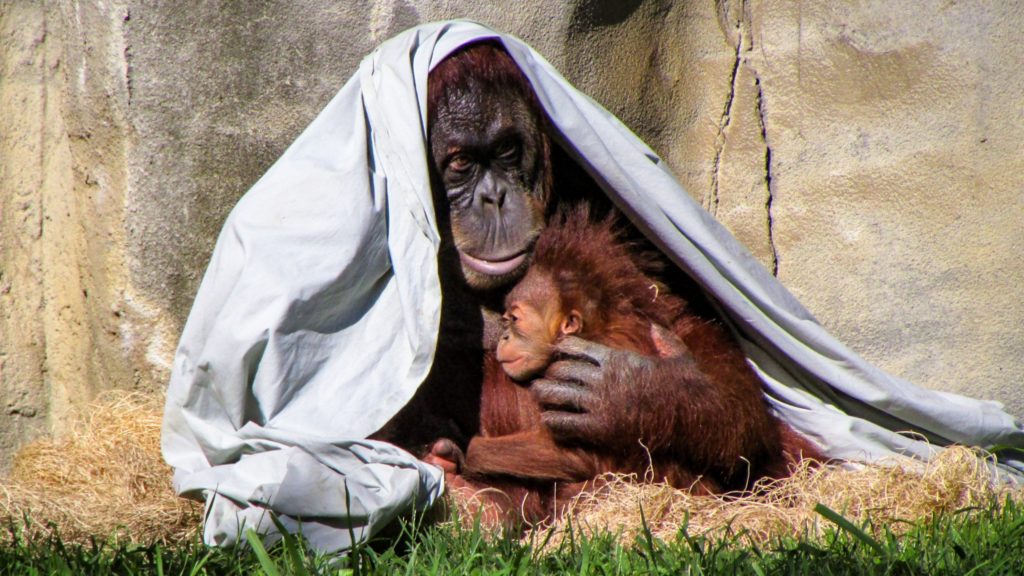In the last article I wrote, we covered the benefits of zoos and aquariums and how they are helping protect endangered species from the threat of extinction. Since we covered a few of the animals’ zoos and aquariums have saved, I thought it would be good to talk about some animals that still need saving. Most of the data we have on the current status of how threatened a species comes from the International Union for Conservation of Nature’s (IUCN) Red List, which as of 2018 includes data on over 100,000 different species. This “Red List” was founded in 1965 as a way to document and monitor the health of species and since its inception, has become the worlds leading authority and most comprehensive inventory on the population status of biological species. The IUCN uses 7 main categories to classify each species that it evaluates:
- Extinct (EX)– The species is currently extinct in the wild and in captivity.
- Extinct in the Wild (EW)– The Species is no longer present in its natural habitat and only exists in captivity or outside its native habitat. The Przewalski’s horse and the Arabian Oryx were considered extinct in the wild.
- Critically endangered (CR)– In a very critical state of endangerment and very likely to become extinct in the near future
- Endangered (EN)– At a high risk of becoming extinct in the wild in the near future.
- Vulnerable (VU)– Very high risk of becoming endangered without human intervention
- Near Threatened (NT)– Highly likely to become Vulnerable or Endangered in the Near Future
- Least Concern (LC)–Unlikely to become extinct in the near future
All of the species that we will be focusing on today are in the Critically Endangered category, due to the fact that these are the species that are in dire need of assistance and intervention if they have even the slightest chance of a future in the wild. However, as you can see by the IUCN’s categories, only species in the Least Concern category are really currently safe and potentially thriving, the rest are in potential or immediate danger of becoming endangered or extinct in the near future. The sobering fact about the sheer number of animals that are going extinct according to this list is that the vast majority of them were put there due to human interference in their natural habitat. As you will clearly see when we dive into specific endangered species is that habitats are extremely complex and even a minor adjustment or change in the natural balance can throw the whole system into complete disarray and result in the irreparable damage to hundreds, if not thousands of organisms. Below is an infographic I made to give you an idea of the current state of endangered species in 2019.
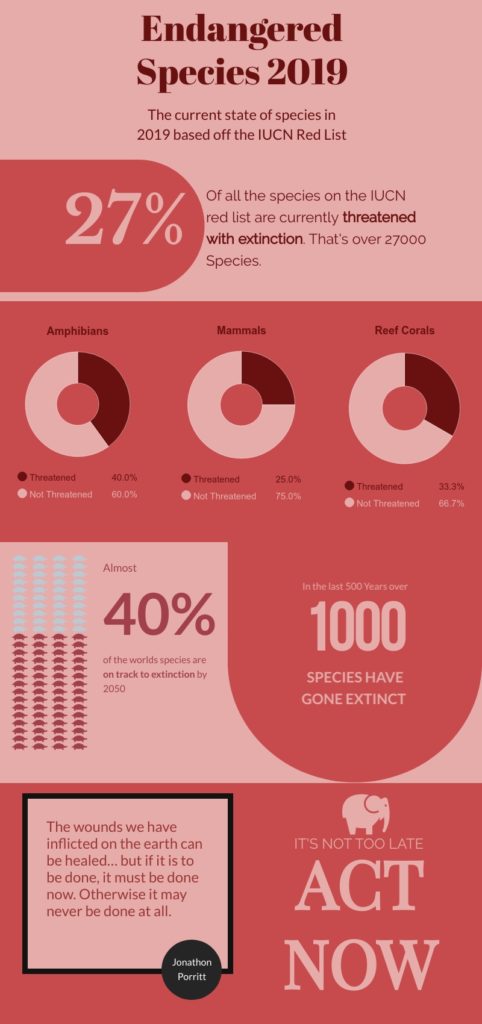
Critically Endangered Species as of 2019
As you can see from the graphic above over 27% of all species on the IUCN red list are threatened with extinction, and that is an astounding number being that there are over 27000 species in that group. You may be thinking that that’s not a huge number because there must be millions of species on the planet so 27000 of them is a relatively small group, but a lot of people don’t realize that there are only around 6000 species of mammals on earth! That means that there are almost 5 times as many species facing extinction today then there are currently mammal species, this really starts to give you an idea of the scale of this issue.
Below I have taken an in-depth look at 8 of the worlds critically endangered species, these are by no means the most endangered species on earth, most of them I have chosen due to the fact that you may never have heard of them and don’t realize what an important role they may play in their ecosystems, others I’ve chosen due to the fact that they are facing very unique and important issues that you can help solve.
Birds
Birds play an important role in almost every ecosystem around the world, from penguins in Antarctica to Flamingos in Argentina. They play important roles in the food chain, from the bottom prey species to a top of the food chain apex predator such as an eagle. They also play an important role as pollinators and seed dispersers and some are even considered keystone species because of this relationship with the ecosystem around them.
Kakapo
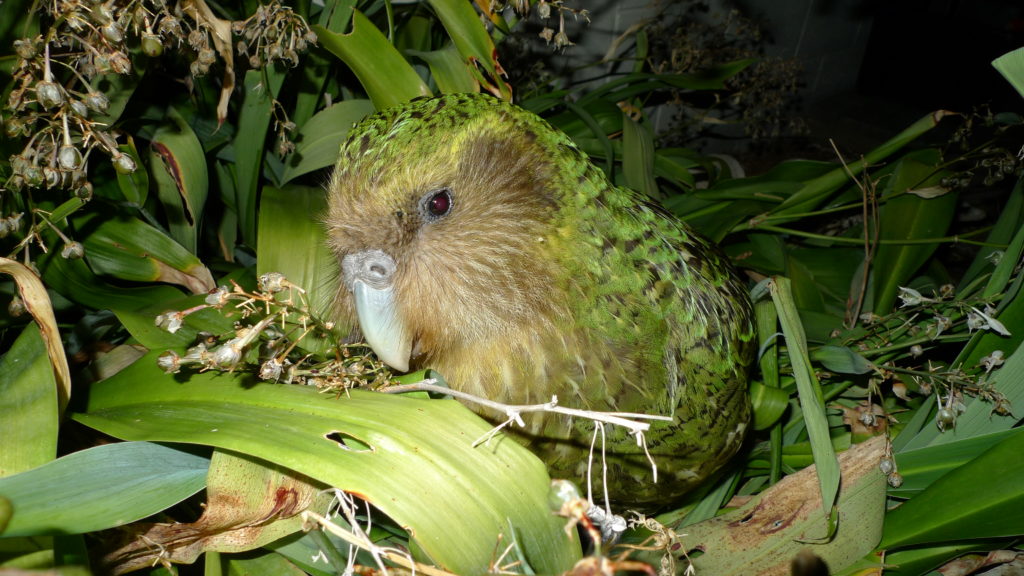
The Kakapo is a critically endangered species of flightless, ground-dwelling parrot that is only found in New Zealand. The name Kakapo actually comes from the native Maori language and means “night parrot” which probably came about due to the fact that this large parrot is also nocturnal, an otherwise completely unique trait among parrots. As well as being the only nocturnal and flightless parrot in the world, the kakapo is also the heaviest parrot (4.4lbs), the only parrot to be herbivorous (only eats plants) and with an average lifespan of 95 years, it is among one of the longest living birds on the planet. Currently, the wild adult population stands at 147 individuals which makes them incredibly rare and extremely vulnerable to extinction, according to the fossil record the Kakapo was once New Zealand’s third most common bird in pre-Polynesian times. There are many things that contributed to the Kakapos decline, one of the main reasons being European settlers introducing predators such as domestic cats, rats and dogs. The Kakapos traits are extremely unique and fascinating but many of them make this parrot extremely susceptible to predation, for instance, Kakapo have a very strong musk scent that allows them to find other Kakapo in the dense forest floor also making them very easy for predators with a strong sense of smell to find, that coupled with the Kakapos primary defence mechanism of freezing to try and blend into the forest, make them easy pickings for mammalian predators.
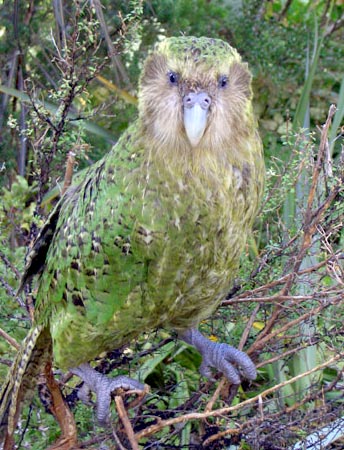
Scientists have been trying to save the Kakapo from extinction since 1891 when they founded the Resolution Island Nature Reserve and began moving the populations around. Today the population of Kakapo is confined to the predator-less islands of Codfish Island and Anchor Island, both of which are strictly monitored. Cutting edge technology is currently being used by biologists in order to ensure the success of these amazing birds:
- Every adult Kakapo has been fitted with an activity monitor/ tracking device so that scientists can tell where they are and if they are mating and with whom.
- Fertile eggs are taken to be incubated in special facilities and the mothers are given 3D printed eggs to sit on until their chicks are returned to them.
- New nests are found with the use of specially trained dogs and scientists camp day and night near them to monitor vulnerable chicks
Due to the incredible conservation efforts by New Zealand and other organizations, Kakapos are making a comeback and as of 2019, are having their most successful breeding season in decades. Make sure to follow Sirocco the Kakapo on Facebook!
California Condor
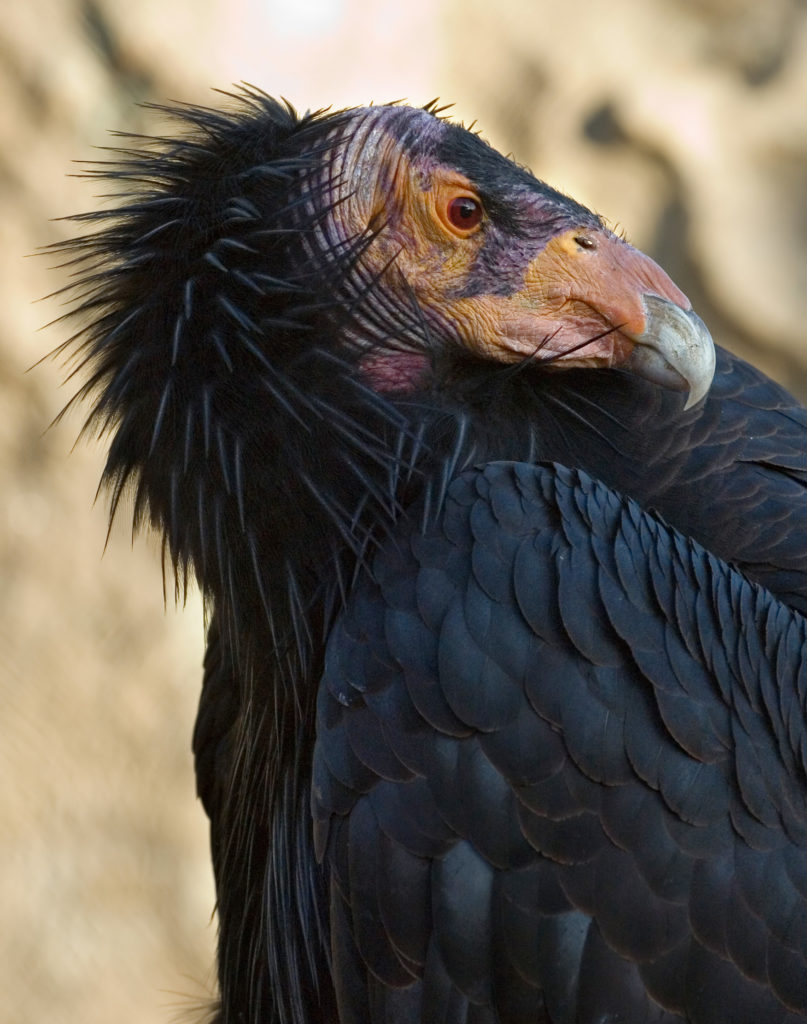
The California Condor is a North American V
Reptiles
Reptiles play a crucial role in their ecosystems as they are integral parts of the food chain as both prey items and as predators. In some ecosystems they act as keystone species that have a tremendous effect on the species around them.
Kemp’s Ridley Sea Turtle
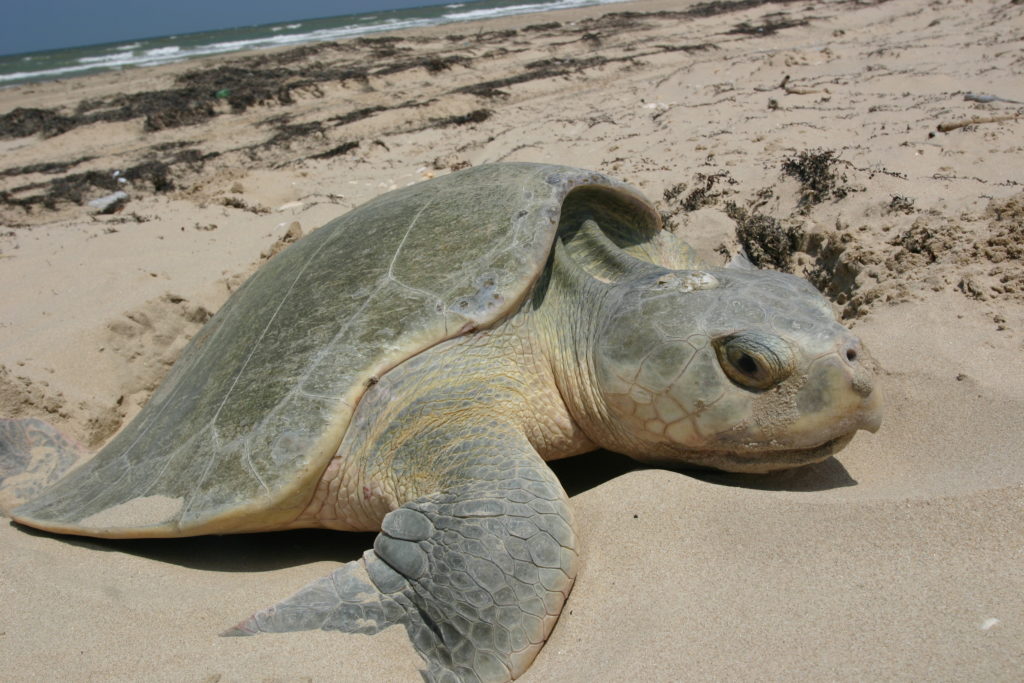
The Kemps Ridley Sea Turtle is the rarest species of sea turtle in existence with less than 1000 turtles left. The Kemps Ridley Sea Turtle is the smallest of the sea turtles, only weighing in at about 100lbs, less than a metre long. Like all other sea turtles, Kemps Ridley Sea Turtles have a very large range and travel throughout the Atlantic, migrating to the Gulf of Mexico to mate and lay their eggs, almost all of the females return to Rancho Nuevo beach in Mexico to lay their eggs which hatch on land in the sand with the babies making their way to the ocean shortly after they hatch. The once thriving population of these sea turtles was decimated by hunting and fishing practices in the 1900s this coupled with water pollution and habitat loss made for a steady decline in numbers throughout the 20th century. Currently, the governments of Texas and Mexico have teamed up in order to help save this species and have implemented various ecological protections to the species including a large captive hatching/ release program as well as new laws on fishing practices. Currently, the populations of Kemps Ridley Sea Turtles are on the decline, but continued human intervention and monitoring will hopefully change that and save this critically endangered species.
Chinese Alligator
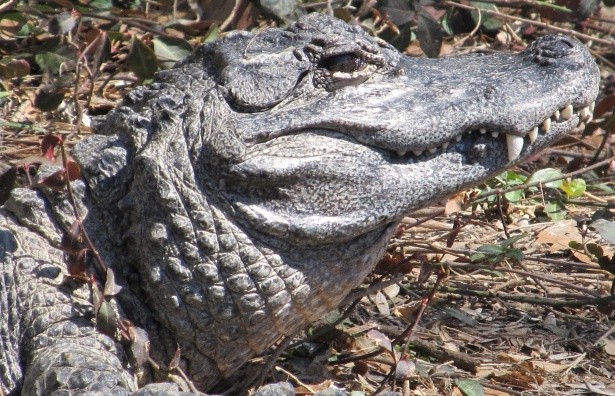
The Chinese Alligator is a critically endangered species and one of the only two species of Alligator left on earth, the other being the American Alligator which is on the other end of the IUCN scale being of least concern. This small alligator only grows to about 5-7ft long and are generally around 90lbs in weight, this is more than half as small as their American cousins. Their small size allows them to dig elaborate tunnels, which they stay in for much of the day and only come out at night to feed. The Chinese Alligator is found exclusively in a few provinces in China but historically has a range as far as Japan, for the last 6000 years the range of this reptile has been shrinking rapidly with the population declining to under 130 individuals in 1970. Many efforts have been made by the Chinese Government in order to try and protect the Chinese Alligator including the creation of the Anhui National Nature Reserve for Chinese Alligator (ANNRCA) in 1982 which gave much of the wild population refuge from human interference. With the foundation of ANNRCA came the largest captive breeding program for Chinese Alligators with the start of the Anhui Research Center for Chinese Alligator Reproduction which currently houses over 15000 Alligators. Currently, there are less than 150 individuals estimated to be alive in the wild but with the continued efforts of the Chinese government the future is looking bright for this critically endangered species.
Amphibians
Amphibians are found all over the world in a variety of ecosystems and play an incredibly important role in each, including consuming a vast amount of insects keeping their populations healthy and in control. They also act as an early warning system for environmental change due to their sensitive skin and will often be the first to exhibit distress due to pollution and other potentially harmful environmental threats.
Chinese Giant Salamander
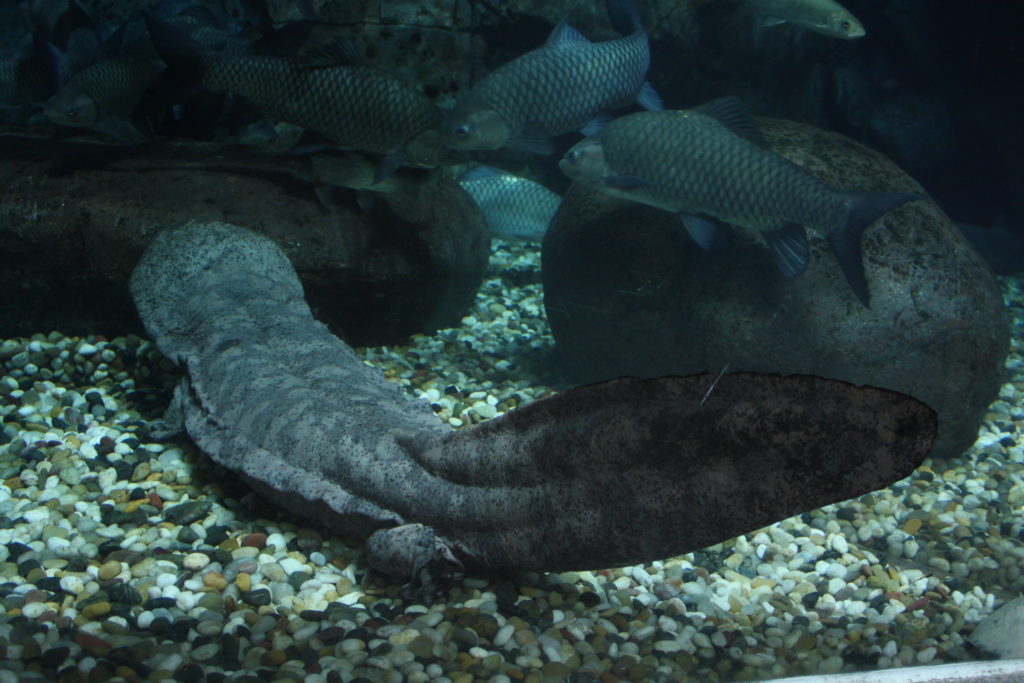
The Chinese Giant Salamander is another critically endangered species on this list that is only found in China, it is also the largest amphibian in the world and is capable of growing to almost 6ft in length and weighing in at over 60lbs. These incredibly large amphibians are the only living relative of a group of prehistoric salamander that existed over 170 million years ago, and although once common, their population is rapidly declining and in desperate need of help. This amphibian has earned the name “infant fish” due to the vocalizations it makes that bear a striking resemblance to the crying of a human baby. The population of this prehistoric reptile have been in rapid decline ever since the 1950s due to habitat loss and over hunting for the Chinese medicine and food industry. Efforts have been made by the Chinese government to stop the decline of this important species through the establishment of farms producing them for the medical and food industries as well as the establishment of the Jing
Panamanian Golden Frog
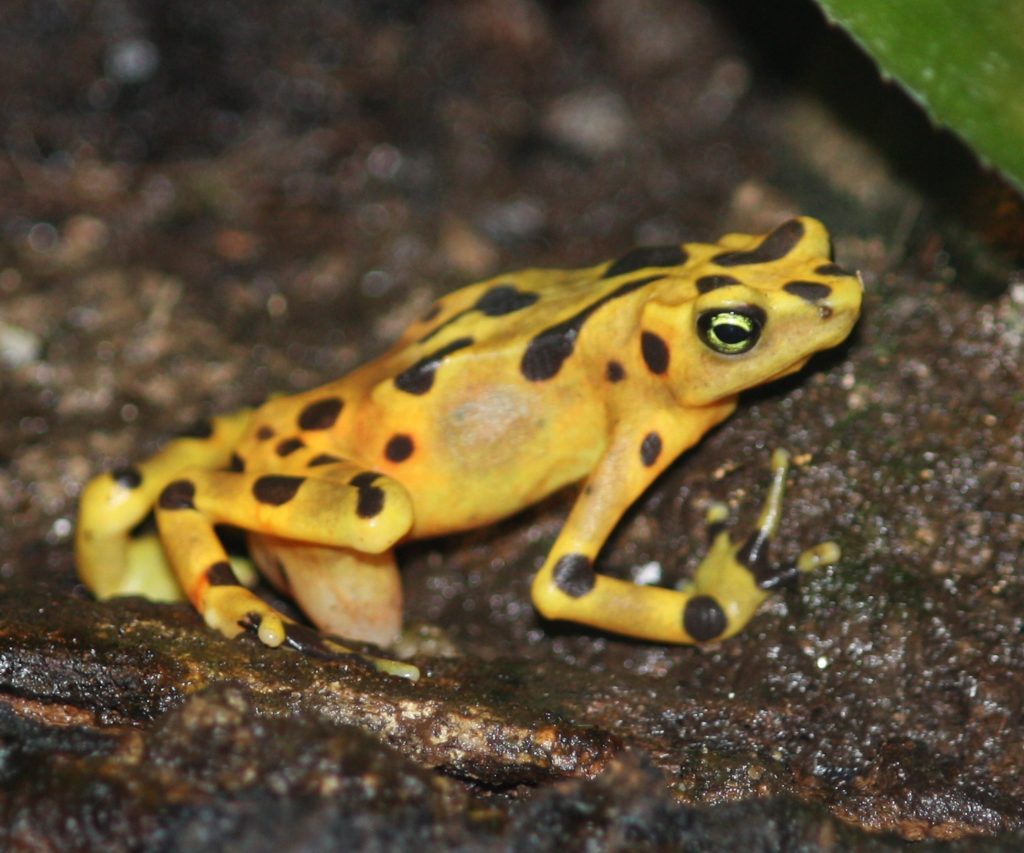
The Panamanian Golden Frog is a critically endangered true toad that is only found in Panama. Although this species is classified as a critically endangered species by the IUCN, experts suspect that it may have become extinct in the wild over 10 years ago. This small but beautiful toad is generally less than 2 inches long but has managed to become Panama’s national animal due to its bright yellow gold complexion. Like many bright coloured animals found in the rainforests, the Golden Frog is extremely poisonous, containing a neurotoxin that could kill a human in less than an hour. These toads are also capable of making whistling noises but generally only communicate with a kind of sign language “waving” their brightly coloured limbs around to ward off predators and attract mates. These once abundant species began to rapidly disappear from the high mountain forests of Panama in the 1990s largely due to a fungal disease called chytridiomycosis which wipes out amphibians. Luckily these species seem to thrive in captivity and several institutions including the San Diego Zoo have implemented very successful captive breeding programs. Until the disease risk has been mitigated these frogs cannot safely be released into the wild without a high risk of becoming infected.
Mammals
Mammals are found in almost every ecosystem on earth and make up an integral part of both the natural world and our human world (especially being a mammal ourselves). Mammals are extremely important to our way of life, we keep them in our house as pets, we use them for agriculture and even rode them to get from point a to point b for thousands of years. Mammals also play an important role in the food chain making up most of the worlds grazers and predators. Humans are mammals which means mammals are the only species with the ability to destroy the world as we know it as well as save it.
Sumatran Orangutan
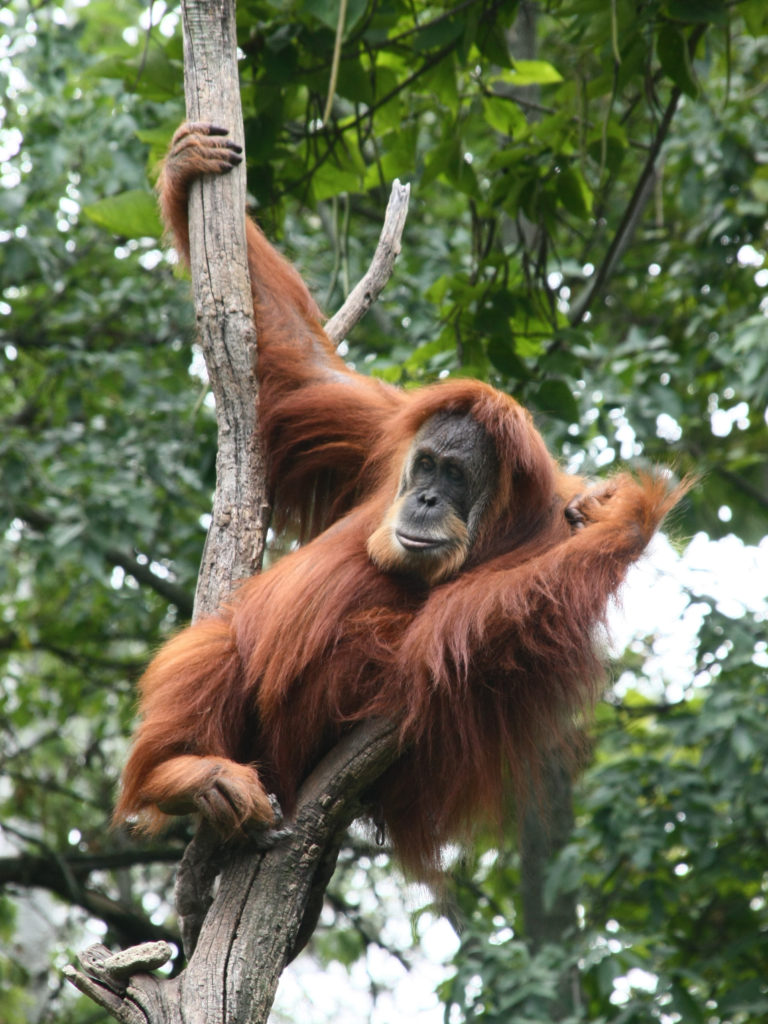
The Sumatran Orangutan is one of three species of Orangutan, all three of which are considered critically endangered species. This species of large ape can grow up to 200lbs and is only found on the Indonesian island of Sumatra, the name Orangutan translates into “person of the forest”. Sumatran Orangutans have a diet that mainly consists of fruit and insects but they will supplement their diet with eggs and even small vertebrates, they are also incredibly patient and intelligent, being observed in the wild using various tools to obtain food. These tools are often fashioned out of tree branches with their teeth and used to dig inside trees for termites, search inside beehives for honey and get at fruits and seeds that are protected with thorns or other defence mechanisms, Orangutans even keep these tools for later if they were useful and accumulate a “toolbox” full of them.
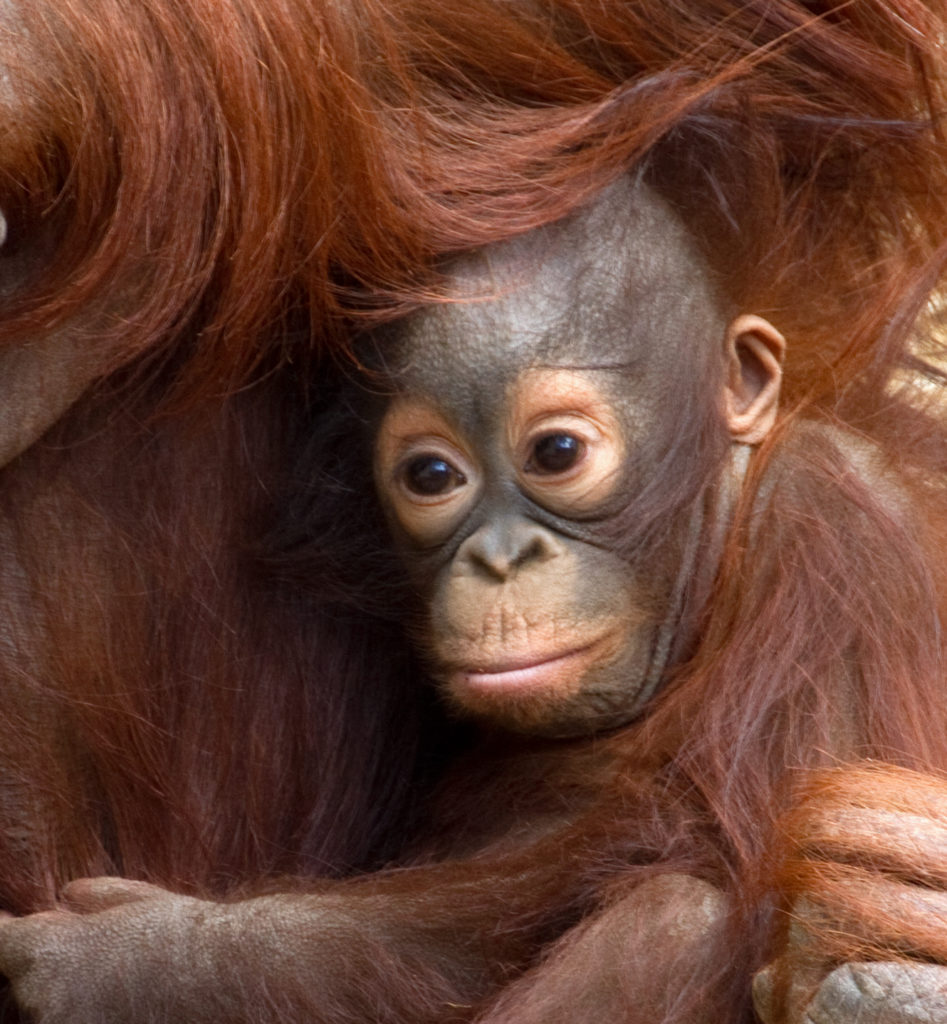
There are a few main problems facing the surviving Orangutan population, which a once common primate is down to around 15000 wild individuals:
- The Palm Oil Industry
- Habitat loss (Generally as a result of palm oil plantations)
- Poaching/ The Illegal Wildlife Trade
The palm oil industry is an extreme threat to the health and longevity of not only Sumatran Orangutans but also to almost all life that resides within the tropical forests of Asia, Africa, and Latin America. This industry is thriving due to the fact that palm oil is found in over half of all packaged goods consumed by Americans and many more goods consumed throughout the world. Palm oil trees are grown in tropical areas that are usually occupied by rainforest, resulting in the mass clearcutting or burning of the natural rain forest, resulting in mass pollution and habitat loss for many species including the Sumatran Orangutan. Currently, Sumatra has the fastest deforestation rate in the world and has lost over half of its forests within just 20 years.
Another of the main threats that are facing the worlds remaining Orangutan populations is the ever-present threat of the illegal wildlife trade. Although it has been illegal to own, kill or capture an Orangutan since the 1930s it is still a very real threat facing wild Orangutans. Unfortunately, the most desired individuals are almost always baby Orangutans which almost always results in the death of the mother in order to retrieve the young. Having a baby Orangutan is viewed as a status symbol and is even practiced by some high ranking Indonesian Officials.
Chinese Pangolin
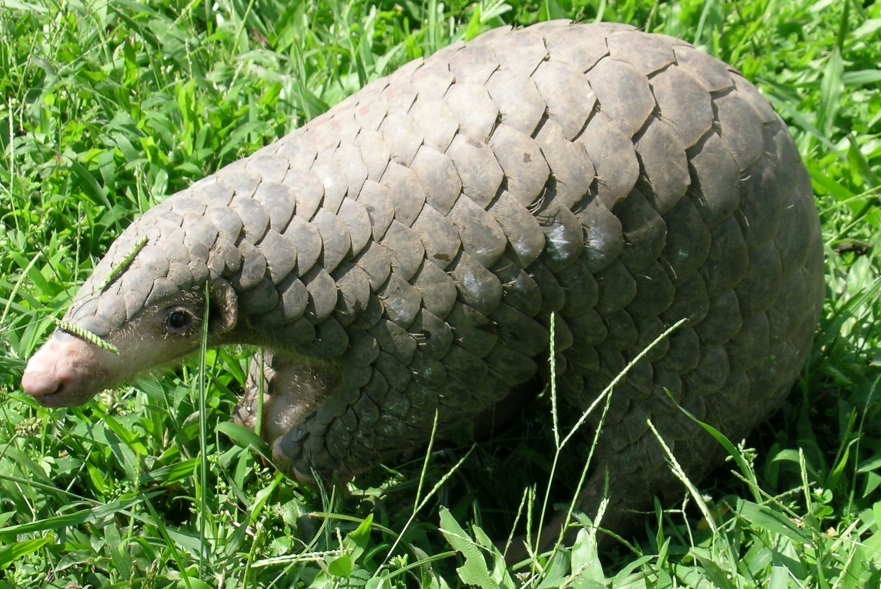
The Chinese Pangolin is one of eight species of pangolin, they are found throughout southern China and Taiwan and parts of southern Asia. All eight of the species of Pangolin are feeling the pressure of endangerment, but both the Chinese Pangolin and the Sunda Pangolin are critically endangered species. These solitary and nocturnal mammals feed almost entirely on ants and termites. The Pangolin is easily identified by its heavily armoured scales that cover the entirety of its body, these scales are its primary defence against predator attacks. The pangolin will roll up in a tight ball when threatened, the name Pangolin comes from the Malay word “
Are these endangered species doomed?
That is a very hard question and is impossible to answer for every species on this list. Ultimately not every animal currently listed as critically endangered are going to survive the next 20-50 years but rest assured many of them will. Every day new legislation is being passed in countries to protect endangered species and thousands of organizations are currently at the forefront of the battle against extinction and although this article was a little gloomier than the ones I usually write, this information is extremely important, as public awareness is a critical driver of change. Predicting the population health of a species is extremely hard to do and takes a lot of funding, manpower and complex algorithms to do correctly but with the help of organizations like the IUCN, it is possible that we are able to monitor the health of a vast majority of animals that are facing extinction now or in the future, and this is critical for their long term survival. Don’t let reading this article be the only thing you do this week to help endangered species, below I’ve attached a document containing a list of all the Critically endangered species currently on the IUCN Red List, look through it and find endangered species in your area or an organization that helps them and see what you can do to help. The best time to plant a tree was 40 years ago, the second best time is now.

